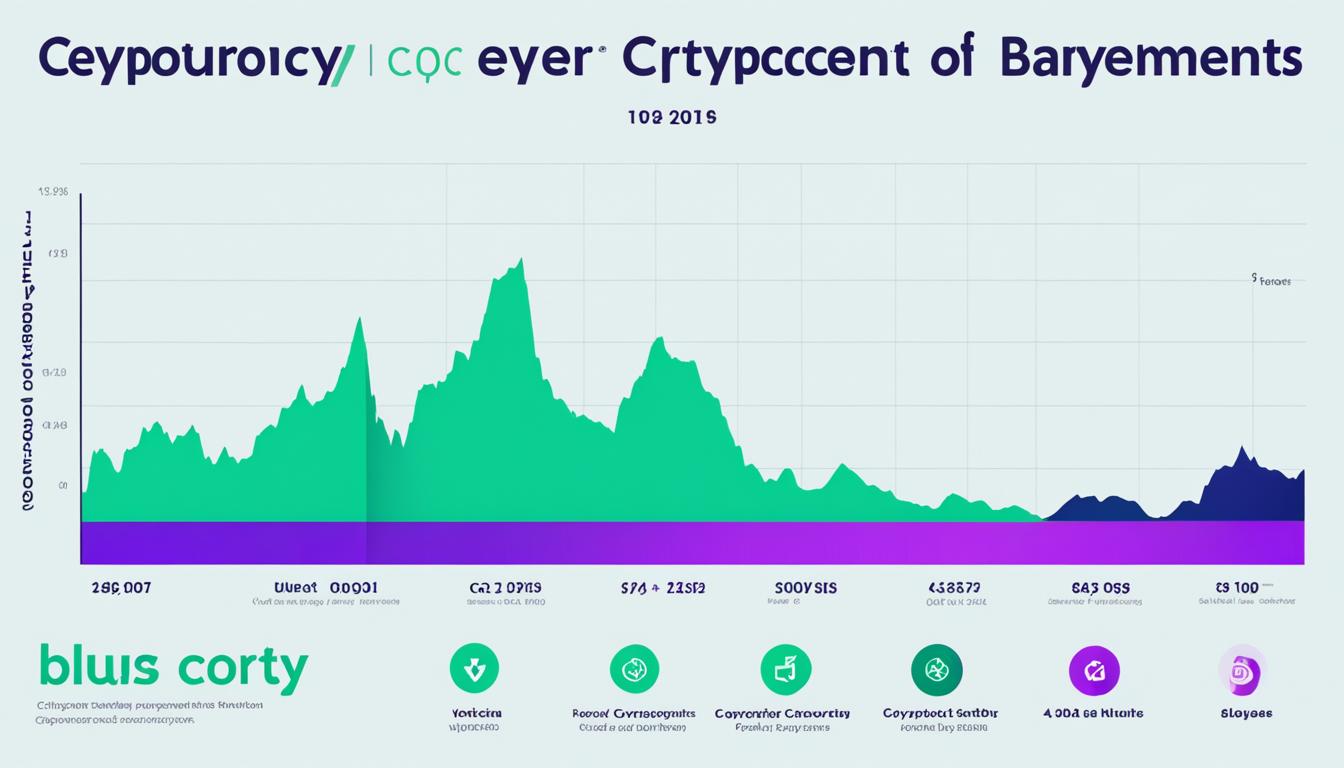In a digital world brimming with innovation, over 106 million people globally have entered the cryptocurrency market. Yet, amidst the surge in adoption, significant misconceptions persist. Common myths about cryptocurrency debunked are not just lines in forums; they represent common crypto misconceptions that can hamper informed decision-making. You may have encountered tales suggesting that digital currencies are shrouded in mystery or mired in illegality, all of which contribute to a complex web of fallacy. Our mission is to dispel cryptocurrency myths, ensuring clarity replaces confusion.
Debunking crypto myths is crucial for both savvy investors and newcomers navigating the intricate cryptocurrency landscape. Take a journey with us as we uncover the truths obscured by widespread folklore and provide insight into the actualities of this transformative financial movement. As we unravel the fabrications, prepare to challenge your knowledge and uncover the realities that can redefine your perspective on digital assets.
Contents
- 1 Crypto Is Just for Criminals
- 2 Crypto Myths Debunked: Understanding Market Volatility
- 3 Bitcoin’s Environmental Impact Misconceptions
- 4 Blockchain Equals Bitcoin and Other Cryptocurrencies
- 5 Cryptocurrency’s Alleged Anonymity Debunked
- 6 The Myth of Easy Riches in Crypto Investing
- 7 Regulatory and Compliance Misconceptions
- 8 Non-Fungible Token (NFT) Myths Explained
- 9 Decentralized Finance (DeFi) Myths Uncovered
- 10 Conclusion
- 11 FAQ
- 11.1 Are cryptocurrencies primarily used by criminals?
- 11.2 Are cryptocurrencies too unstable for serious investment?
- 11.3 Does Bitcoin mining have a significant impact on the environment?
- 11.4 Is blockchain technology only used for financial applications?
- 11.5 Are cryptocurrencies anonymous?
- 11.6 Does investing in cryptocurrencies guarantee quick wealth accumulation?
- 11.7 Are cryptocurrencies subject to regulatory and compliance concerns?
- 11.8 Are NFTs only digital artworks with no real value?
- 11.9 Is it complicated to participate in DeFi?
- 11.10 What are the key takeaways from debunking cryptocurrency myths?
Key Takeaways
- Understanding the truths behind cryptocurrency can empower more informed investment decisions.
- Dispelling cryptocurrency myths is essential for recognizing the potential and limits of digital currencies.
- Exploring the nuances of cryptocurrencies reveals their legitimacy beyond the veil of common misconceptions.
- Breaking down stereotypes and misinformation is key to appreciating the true scope of crypto’s impact.
- Awareness of the reality versus the myths of cryptocurrency fosters a healthier, more transparent market.
Crypto Is Just for Criminals
The narrative that Crypto Is Just for Criminals is a persistent one, clouding public perception and bolstering numerous cryptocurrency myths. Yet the reality is more nuanced, and the mission to dispel cryptocurrency myths involves shedding light on the legitimate and myriad uses of crypto. While the specter of illicit activities can’t be entirely dismissed, it’s essential to debunk crypto myths to foster a balanced understanding of this innovative financial landscape.
Contrary to the popular myth, the vast majority of cryptocurrency transactions are not related to illegal activities. According to a report by Chainalysis, illicit transactions accounted for just 0.34% of all cryptocurrency activity in 2020.
Breaking down the misconception starts with recognizing the diversification in the use of cryptocurrencies:
- International remittances
- Investing and personal finance
- Asset tokenization
- Decentralized services and applications
Not only are cryptocurrencies being integrated into legitimate financial operations, but they also offer innovative solutions to existing financial challenges, such as high transaction fees and slow processing times for cross-border payments.
| Cryptocurrency Use Case | Legitimate Purposes | Myth vs. Reality |
|---|---|---|
| Payment for Goods and Services | Used by a multitude of businesses globally | Often assumed exclusively for dark web transactions |
| Fund Raising (ICOs, STOs) | Startup financing and project crowdfunding | Believed to lack regulation and promote fraud |
| Privacy Transactions | Protecting user’s financial privacy | Mistakenly associated only with illegal activities |
| Smart Contracts | Automating agreements without intermediaries | Mythically linked to untraceable, illegal contracts |
Moreover, the blockchain technology underlying most cryptocurrencies promotes transparency and traceability, which makes it difficult for criminals to engage in activities like money laundering without leaving a digital trail that law enforcement can track.
In conclusion, while it’s critical to remain vigilant about the potential for misuse in any financial system, branding cryptocurrency as a tool for only the corrupt is a disservice to its potential and the positive impact it is already having worldwide. As we continue to navigate the evolving digital currency landscape, remember that debunking crypto myths is a collective responsibility to ensure a well-informed public discourse.
Crypto Myths Debunked: Understanding Market Volatility
When considering any investment, it’s important to understand market volatility, and in the realm of digital currencies, debunking crypto myths is essential. Amidst concerns that cryptocurrencies are too unstable for serious investment, it’s vital to recognize that market fluctuations are part and parcel of financial growth and innovation, not signs of inherent instability. Let’s delve into the common crypto misconceptions and separate fact from fiction.
Myth: Cryptocurrencies Are Too Unstable for Serious Investment
The assertion that cryptocurrencies are too unstable for serious investment overlooks the potential of digital assets in a diversified portfolio. While it’s true that cryptocurrencies can exhibit sharp price movements, this volatility can also create opportunities for astute investors who understand how to navigate the market conditions. Moreover, as the crypto market matures, increased liquidity and institutional participation are likely to temper volatility over time.
Myth: Volatility Makes Crypto a Poor Store of Value
It’s often claimed that volatility makes crypto a poor store of value, but let’s consider the broader perspective. While prices do fluctuate, many investors see cryptocurrencies as a hedge against inflation and currency devaluation. Over longer periods, some cryptocurrencies have maintained an overall trend of growth, challenging the notion that they can’t serve as a store of value. Still, it’s crucial to research individual assets, as not all are created equal or will perform similarly.
Reflecting on the dynamic nature of cryptocurrencies, we find that understanding their behavior is key to leveraging their full potential. By moving past common crypto misconceptions, such as the overstated impact of volatility, you can gain a more nuanced appreciation of what digital currencies have to offer. As with any investment, informed decisions based on robust analysis will yield the best results, defying the assumption that cryptocurrencies are too unstable for serious investment.
Bitcoin’s Environmental Impact Misconceptions
When you hear about Bitcoin, one of the prevalent concerns that often surfaces is its environmental impact. Debunking crypto myths necessitates a factual exploration of these concerns. Let’s demystify common crypto misconceptions through an examination of the data behind Bitcoin’s actual energy consumption and its comparison to other industries.
Many claim that Bitcoin mining is an environmental disaster waiting to happen, yet the truth is much more nuanced than such blanket statements suggest.
Dispelling cryptocurrency myths concerning energy use starts with understanding the complexities of Bitcoin mining. Compared to traditional financial systems and other industries, Bitcoin’s energy usage has a different structure and potential for sustainable practices.
To clarify Bitcoin’s Environmental Impact Misconceptions, consider the following points:
- Bitcoin miners are increasingly adopting renewable energy sources to reduce their carbon footprint.
- Economic incentives are pushing the industry towards more energy-efficient mining hardware.
- The global banking system and gold mining consume significantly more energy than Bitcoin mining.
Here’s how Bitcoin’s energy consumption compares to other sectors:
| Industry | Annual Energy Consumption | Percentage of Renewables Used |
|---|---|---|
| Global Banking System | 263.72 TWh | N/A |
| Gold Mining | 132 TWh | Small portion* |
| Bitcoin Mining | Est. 89 TWh | Increasing rapidly |
*Estimates suggest renewable energy makes up a small fraction of total energy used in gold mining.
In the context of Bitcoin’s environmental impact, it’s clear that a comprehensive understanding is necessary. As we continue to propel towards a more sustainable future, the focus should be on supporting green initiatives within the Bitcoin mining industry rather than dwelling on cryptocurrency myths. In doing so, we not only debunk crypto myths but also encourage responsible innovations in this transformative digital era.
Blockchain Equals Bitcoin and Other Cryptocurrencies
The conflation of blockchain technology with Bitcoin and other cryptocurrencies is one of the most prevalent misunderstandings in the digital realm. While Bitcoin relies on blockchain, the technology itself has a broad spectrum of applications that go beyond cryptocurrencies. In debunking these crypto myths, it’s crucial to understand the distinction between blockchain and Bitcoin and to recognize the common crypto misconceptions that often cloud public perception.

Myth: All Blockchains Are Public and Not Private
Contrary to a common crypto misconception, blockchains are not exclusively public. While the Bitcoin blockchain is public, allowing anyone to view transactions, there exist private blockchains where access is restricted. These private blockchains are often used within organizations to maintain confidentiality and control over sensitive data. The key here is understanding that the flexibility of blockchain technology enables both public and private applications, signifying that blockchain equals Bitcoin and other cryptocurrencies is a misinformed statement.
Myth: Blockchain Technology Is Only for Financial Applications
Decoupling blockchain technology from the financial-centric view, it’s important to highlight its diverse applications. Beyond cryptocurrency transactions and financial exchanges, blockchain technology is instrumental in supply chain management, healthcare for secure patient data handling, and even in the creative industry for protecting intellectual property. Debunking this crypto myth, blockchain’s relevance extends into virtually any domain where secure, transparent record-keeping is paramount.
| Blockchain Application | Description | Example |
|---|---|---|
| Supply Chain Management | Provides an unfalsifiable record of product journey from manufacturer to consumer | Walmart’s tracking of produce for enhanced safety |
| Healthcare Records | Ensures the integrity and security of patient data across various service providers | Hospital networks maintaining accessible yet secure patient histories |
| Intellectual Property Protection | Records and verifies ownership and licensing of digital and creative assets | Artists registering their work to prevent unauthorized usage |
In dispelling these common crypto misconceptions, it becomes evident that the misconception suggesting that blockchain technology is only for financial applications requires rectification. Blockchains are adaptable and can transcend Bitcoin and other cryptocurrencies, showcasing their versatility across a multitude of industries.
By debunking crypto myths and shedding light on the expansive capabilities of blockchain, one can appreciate its revolutionary potential beyond the confines of digital currency. As we continue to explore and innovate, the narrative around blockchain and cryptocurrency evolves, breaking away from the engrained myths to a future ripe with unparalleled technological possibilities.
Cryptocurrency’s Alleged Anonymity Debunked
As the digital currency landscape matures, it’s crucial to address common crypto misconceptions, particularly the idea of cryptocurrency’s alleged anonymity. While you may have heard that cryptocurrencies offer complete anonymity, the truth is more nuanced. What you’re encountering is a form of pseudonymity, a concept often misunderstood. Let’s delve into debunking crypto myths, especially the one surrounding anonymity, to shed light on what privacy really means in the world of digital assets.
“The public nature of the blockchain ledger allows for more transparency than you might expect with cryptocurrency transactions.”
In the interest of dispelling cryptocurrency myths, it’s important to comprehend that every transaction made using cryptocurrency is recorded on a public ledger. This blockchain ledger, contrary to what the myths suggest, allows every transaction to be traced back to its source by anyone with the means to do so.
However, the users behind these transactions are represented by strings of characters known as addresses, rather than personally identifiable information. This is the core of cryptocurrency’s pseudonymity. Despite this layer, one should not fall into the trap of believing in full-fledged anonymity. Responsible entities are constantly improving their methods of connecting addresses with real-world identities, which may eviscerate the privacy shield that many believe they have in place.
| Aspect of Anonymity | Myth | Reality |
|---|---|---|
| Transaction Record | Transactions are invisible. | All transactions are publicly recorded on the blockchain. |
| User Identity | User identities are completely hidden. | Addresses represent users, but connections to real identities can be made. |
| Regulatory Compliance | Cryptocurrencies operate outside regulatory scope. | Regulators can trace transactions and enforce compliance, negating the myth of complete autonomy. |
| Privacy Tools | Privacy-centric coins offer absolute anonymity. | Even privacy coins can sometimes be compromised by sophisticated tracking methods. |
Through focused efforts on debunking crypto myths, we realize the simplicity of associating cryptocurrency with the dark web or illegal activities due to perceived clandestine nature. However, in laying out the facts, we expose the common crypto misconceptions. And as you become more informed, you are better equipped to engage with the crypto space responsibly while understanding the extent and limitations of your privacy.
- Cryptocurrency is not synonymous with invisibility in financial transactions.
- The perceived privacy in digital currencies can be deceptive.
- Understanding the nature of blockchain and cryptocurrency is essential in grasping the actual levels of anonymity involving these currencies.
Overall, the narrative of cryptocurrency offering a haven for those seeking absolute secrecy is one of the many myths ripe for debunking. Rather than clinging to this narrative of unfounded anonymity, it’s time to move towards a more realistic understanding of cryptocurrency—paving the way for clearer regulation, heightened security, and smarter adoption strategies.
The Myth of Easy Riches in Crypto Investing
As you navigate the digital currency landscape, it’s crucial to confront one of the most pervasive cryptocurrency myths: the illusion of effortless wealth. The seductive narrative of becoming an instant millionaire has been propagated far and wide, but it’s time to pull back the veil on the reality of crypto investing.
Myth: Cryptocurrency Guarantees Quick Wealth Accumulation
Investing in cryptocurrencies like Bitcoin, Ethereum, and others has been heralded by some as a guaranteed route to financial success. However, claims like “Cryptocurrency Guarantees Quick Wealth Accumulation” are misleading. The complex ecosystem of crypto markets is influenced by a multitude of factors, making it speculative and highly volatile.
Myth: You Can Become a Millionaire Overnight Without Risks
The infatuation with stories of people making fortunes virtually overnight can lead many to believe You Can Become a Millionaire Overnight Without Risks. Debunking this crypto myth requires acknowledgment of the market’s unpredictability and the inherent risks involved in trading and investing in cryptocurrencies.

Let’s dissect these common crypto misconceptions with factual scrutiny:
| Myth | Reality |
|---|---|
| Immediate, high returns are standard in crypto investing. | While some have reaped significant returns, this is not the norm, and losses can be equally dramatic. |
| Cryptocurrencies are a safe haven, immune to market trends. | Crypto assets are subject to market sentiment, technological shifts, regulatory changes, and other external factors. |
| Investments in crypto require minimal effort and knowledge. | Successful crypto investing necessitates diligent research, strategy, and ongoing education. |
In conclusion, the intricate realities of the crypto market expose the fallacy that The Myth of Easy Riches in Crypto Investing is just that—a myth. As you explore the potential of digital assets, engage with the space thoughtfully and cautiously to navigate the nuanced probability of returns against risks.
Regulatory and Compliance Misconceptions
As you navigate the complex landscape of cryptocurrencies, understanding the regulatory and compliance dynamics is crucial. There’s a prevalent myth that digital currencies operate outside of the legal framework, but we’re here to debunk this and other common crypto misconceptions.
Let’s first dismiss the myth that cryptocurrencies are unregulated and lack legal oversight. In reality, the sphere of digital assets is increasingly coming under the purview of various regulatory bodies. This shift signifies a positive step towards dispelling cryptocurrency myths about a lack of governance.
Another widespread misconception is that all cryptocurrencies follow the same regulatory standards. In fact, the regulatory and compliance landscape is varied and depends on jurisdiction. Here’s a snapshot of how different regions approach cryptocurrency regulation:
| Region | Regulatory Outlook |
|---|---|
| United States | Securities and Exchange Commission (SEC) & Commodity Futures Trading Commission (CFTC) involvement, with state-level variations. |
| European Union | Markets in Crypto-Assets (MiCA) regulation in proposal stages for harmonizing the approach across member states. |
| Asia | Mixed approaches with countries like Japan having clear frameworks, while others maintain a restrictive stance. |
| Global | Financial Action Task Force (FATF) providing international standards for anti-money laundering (AML). |
In dispelling cryptocurrency myths, it’s important to acknowledge the complication inherent in the word “compliance”. With evolving technology and the innovative nature of cryptocurrencies, keeping abreast of updated regulations is a challenge for both users and authorities.
“Regulations are playing catch-up with technology, but the direction is clear: cryptocurrencies will be integrated into the global financial system, with compliance playing a pivotal role.”
– Speaker at a leading blockchain summit
Part of debunking crypto myths involves understanding the intent behind regulations – protecting consumers, preventing fraud, and maintaining orderly markets. Therefore, regulatory developments should be seen as milestones in the maturation of the industry rather than constraints.
So, whether you’re investing, developing, or just casually using cryptocurrencies, stay informed. You are the protagonist in the narrative of dispelling cryptocurrency myths and ushering in an era of informed blockchain interaction.
Non-Fungible Token (NFT) Myths Explained
Despite the meteoric rise of non-fungible tokens, or NFTs, misconceptions cloud their true nature and potential. This section navigates through common NFT myths, ensuring you have a clearer picture of what NFTs represent beyond the digital landscape and simplifying the complexity surrounding their creation and ownership.
Myth: NFTs Are Only Digital Artworks with No Real Value
One of the prevailing NFT myths is that they are synonymous with digital art that holds no intrinsic value. However, NFTs are much more than just digital collectibles; they represent a unique asset class that can encapsulate ownership of various items, such as music, videos, and even real estate in the virtual world. Dispelling NFT myths, it’s crucial to understand that the value of NFTs lies in their uniqueness and the immutable proof of ownership provided by blockchain technology.

Myth: Creating or Owning NFTs Is a Complicated Process
Another common misconception is that the process of creating or owning NFTs is overly technical and inaccessible to the average person. On the contrary, the proliferation of user-friendly platforms has made it easier than ever to create and trade NFTs. Far from the esoteric, complex system some imagine, engaging with NFTs often requires nothing more than a basic understanding of cryptocurrency and access to a digital wallet. In essence, dispelling NFT myths, the NFT market is designed to be inclusive, empowering artists and collectors to partake in this digital renaissance.
In conclusion, NFTs carry real value and are accessible to a broader audience than is often portrayed. By demystifying the aura that surrounds Non-Fungible Token (NFT) Myths Explained, we see that they are an integral part of the evolving cryptocurrency landscape, with potential that transcends digital art and opens up new avenues for ownership and investment.
Decentralized Finance (DeFi) Myths Uncovered
As you navigate the ever-evolving world of Decentralized Finance (DeFi), it is crucial to distinguish the reality from fiction. Despite its significant progress, the DeFi sector is still shrouded in misconceptions. This article aims to shed light by dispelling DeFi myths and tearing down the walls of misunderstanding that surround it.
DeFi myths often discourage potential users from exploring the remarkable opportunities available in this dynamic space. Let’s take a closer examination and debunk some of the most common myths:
- DeFi is too complex for the average user: While DeFi platforms may present a steep learning curve, recent advancements have made the user experience more intuitive. Education and user-friendly interfaces are making DeFi increasingly accessible.
- DeFi lacks security: While concerns surrounding smart contract vulnerabilities exist, the DeFi community prioritizes security with audits, insurance mechanisms, and continuous improvement of protocols.
- DeFi is only for crypto experts: DeFi is designed to be inclusive, allowing anyone with an internet connection to participate. With a basic understanding of cryptocurrency and blockchain, even new users can benefit from DeFi services.
- DeFi has no real-world use cases: Contrary to this myth, DeFi provides tangible solutions such as decentralized exchanges, lending and borrowing platforms, and yield farming opportunities that have real-world financial utility.
An essential aspect of navigating the cryptocurrency landscape is debunking crypto myths. Doing so will not only enhance your understanding but also enable you to make informed decisions within the DeFi ecosystem.
Conclusion
As we reach the close of our exploration, it’s vital to reflect on the clarity gained about the digital currency world. Throughout this article, we have undertaken the task of meticulously dispelling crypto myths that often cloud the judgment of professionals and enthusiasts alike. You’ve observed how the label of cryptocurrencies being a hub for criminal activity lacks a broad grasp of the legitimacy prevalent in most transactions. Furthermore, we’ve clarified that market volatility, while present, is not an insurmountable barrier — it is a characteristic of many emerging financial markets, not exclusive to the realm of crypto.
The misconception surrounding Bitcoin’s environmental impact, the over-simplification equating blockchain with Bitcoin, and the misunderstood nature of cryptocurrency anonymity are but a few of the cryptocurrency myths debunked in our discussion. In the process, we’ve also unraveled the truth about the fabled overnight riches in crypto investing, countered regulatory fears, and explored the rich diversity and potential in Non-Fungible Tokens (NFTs) and Decentralized Finance (DeFi).
Our journey through these common cryptocurrency misconceptions has not just shed light on what these digital assets are not but also illuminated the vast array of what they offer to contemporary finance. The key takeaways from this comprehensive analysis should equip you with the knowledge to navigate the crypto space with renewed confidence and insight. With these myths set aside, you are now better positioned to leverage the innovative opportunities cryptocurrencies present, and are prepared to engage with the future of finance with an informed and discerning perspective.









Leave a Reply